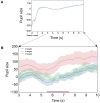Fixation duration surpasses pupil size as a measure of memory load in free viewing
- PMID: 25653606
- PMCID: PMC4301010
- DOI: 10.3389/fnhum.2014.01063
Fixation duration surpasses pupil size as a measure of memory load in free viewing
Abstract
Oculomotor behavior reveals, not only the acquisition of visual information at fixation, but also the accumulation of information in memory across subsequent fixations. Two candidate measures were considered as indicators of such dynamic visual memory load: fixation duration and pupil size. While recording these measures, we displayed an arrangement of 3, 4 or 5 targets among distractors. Both occurred in various orientations. Participants searched for targets and reported whether in a subsequent display one of them had changed orientation. We determined to what extent fixation duration and pupil size indicate dynamic memory load, as a function of the number of targets fixated during the search. We found that fixation duration reflects the number of targets, both when this number is within and above the limit of working memory capacity. Pupil size reflects the number of targets only when it exceeds the capacity limit. Moreover, the duration of fixations on successive targets but not on distractors increases whereas pupil size does not. The increase in fixation duration with number of targets both within and above working memory capacity suggests that in free viewing fixation duration is sensitive to actual memory load as well as to processing load, whereas pupil size is indicative of processing load only. Two alternative models relating visual attention and working memory are considered relevant to these results. We discuss the results as supportive of a model which involves a temporary buffer in the interaction of attention and working memory.
Keywords: attention; eye movements; fixation duration; memory load; processing load; pupil size; visual search; working memory.
Figures





References
-
- Andreassi J. L. (2000). “Pupillary response and behavior,” in Psychophysiology: Human Behavior and Physiological Response, (Mahwah, NJ: Lawrence Erlbaum Assoc.), 218–233.
-
- Beatty J., Lucero-Wagoner B. (2000). “The pupillary system,” in Handbook of Psychophysiology, eds Cacioppo J. T., Tassinary L. G., Berntson G. G. 2nd Edn. (Cambridge, England: Cambridge University Press; ), 142–162.
LinkOut - more resources
Full Text Sources
Other Literature Sources

